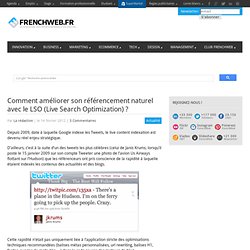

Le SEO illustré en une infographie. Start-up Hiring: Recruit in Silicon Valley or Silicon Alley? You’re looking to bring fresh talent into your start-up and you want to find the best engineers, product managers, and all-around go-getters who can take your company to the next level.
The Bay Area and New York are the foremost places to find impressive resumes, but the two scenes are nothing alike. Or at least so says Michael Dsupin of IT staffing firm Talener, which has offices in both as well as in Los Angeles and has helped companies like AOL, Thrillist, and Business Insider find talent. I spoke with Dsupin recently and he gave me his take on what you're going to get from each coast: They’re completely different ecosystems. Silicon Valley is product based—think Cisco, HP, and Apple. In New York, business tends to focus on finance, legal, advertising and publishing, and start-ups are often still considered quite risky. Location matters in the Valley, but not in the Alley. In Silicon Valley it’s a different matter altogether, with Palo Alto still the center of the universe.
Is Starting A Business Safer Than Your Job? [Infographic] What's Better - Getting a Job or Starting a Business?
![Is Starting A Business Safer Than Your Job? [Infographic]](http://cdn.pearltrees.com/s/pic/th/starting-business-safer-than-17926040)
With a slow economy, many people have turned to entrepreneurship as a means to pay the bills. Which begs the question, what’s better today — getting a job or starting a business? We dug deep to find out the numbers and have compared the risk of starting a business to keeping a job. If you’ve ever thought about starting your own company, take a look at our graphic below to help decide if entrepreneurship is right for you. What do you think? Small Business Loans Made Simple Create a Free Lendio Account Overview “Laid off? “True entrepreneurs reduce risk to the point that action becomes quite logical.” Unemployment Rate: 9.1% Comment améliorer son référencement naturel avec le LSO (Live Search Optimization) ? Depuis 2009, date à laquelle Google indexe les Tweets, le live content indexation est devenu réel enjeu stratégique.

D’ailleurs, c’est à la suite d’un des tweets les plus célèbres (celui de Janis Krums, lorsqu’il poste le 15 janvier 2009 sur son compte Tweeter une photo de l’avion Us Airways flottant sur l’Hudson) que les référenceurs ont pris conscience de la rapidité à laquelle étaient indexés les contenus des actualités et des blogs. Cette rapidité n’était pas uniquement liée à l’application stricte des optimisations techniques recommandées (balises métas personnalisées, url rewriting, balises H1, footer, nuages de mots clés,…) dans le code source des moteurs de blog. L’inclusion des dates, sous forme de variables chiffres, dans les url a clairement joué un rôle décisif dans l’indexation. Une étape majeure a été franchie lorsque Google a rendu public son projet « Google Instant » (ou « Google Inside Search »). Cette tendance n’est pas réservée à Google.
François Sutter.